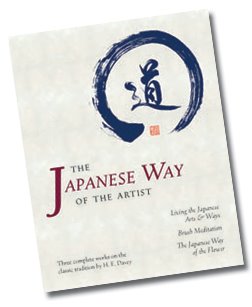Living the Japanese Arts & Ways is out of print, but the entire book is now offered in The Japanese Way of the Artist (Stone Bridge Press). What's more, you'll also get two of my other out of print titles: Brush Meditation and The Japanese Way of the Flower.
Shodo (the "Way of Japanese calligraphy"), budo (the "martial Way"), and kado (the "Way of flower arrangement") are just some of the numerous Japanese arts ending in “Do,” indicating “the Way.” Nonetheless, how these arts function as Ways isn’t always understood.
It’s common to state that these various disciplines represent a Way of life (thus the designation “Do”), and that by practicing, we can transcend them and grasp the art of living. While this is true, it’s uncommon to find a teacher (or book) that can explain how such Do forms lead to spiritual realization. While some books pay lip service to the ideal of the Way producing spiritual evolution, they also sometimes fail to offer direct explanations and methodologies to help students realize the Way. It’s frequently assumed that merely manipulating a brush or throwing an opponent will produce profound realizations.
This is untrue and unfortunate. It’s untrue because it’s the manner in which we approach the Ways that determines what we learn from them. Spiritual realization isn’t guaranteed.
It’s unfortunate because the conscious practice of Japanese Do forms truly can result in the cultivation of mind and body. But to use them as meditation, we must investigate exactly how they can lead to realization.
Japanese calligraphy, flower arrangement, tea ceremony, martial arts, and other Do has been the subject of numerous books. Few of these works, however, have explored how they go beyond art and enter into spirituality. Even fewer have offered methods to practice what can be thought of as “moving meditation,” and which are needed for personal growth to take place.
My book was written to answer that need, and I'm grateful for the kind reviews as well as the positive worldwide response.
Shodo (the "Way of Japanese calligraphy"), budo (the "martial Way"), and kado (the "Way of flower arrangement") are just some of the numerous Japanese arts ending in “Do,” indicating “the Way.” Nonetheless, how these arts function as Ways isn’t always understood.
It’s common to state that these various disciplines represent a Way of life (thus the designation “Do”), and that by practicing, we can transcend them and grasp the art of living. While this is true, it’s uncommon to find a teacher (or book) that can explain how such Do forms lead to spiritual realization. While some books pay lip service to the ideal of the Way producing spiritual evolution, they also sometimes fail to offer direct explanations and methodologies to help students realize the Way. It’s frequently assumed that merely manipulating a brush or throwing an opponent will produce profound realizations.
This is untrue and unfortunate. It’s untrue because it’s the manner in which we approach the Ways that determines what we learn from them. Spiritual realization isn’t guaranteed.
It’s unfortunate because the conscious practice of Japanese Do forms truly can result in the cultivation of mind and body. But to use them as meditation, we must investigate exactly how they can lead to realization.
Japanese calligraphy, flower arrangement, tea ceremony, martial arts, and other Do has been the subject of numerous books. Few of these works, however, have explored how they go beyond art and enter into spirituality. Even fewer have offered methods to practice what can be thought of as “moving meditation,” and which are needed for personal growth to take place.
My book was written to answer that need, and I'm grateful for the kind reviews as well as the positive worldwide response.
